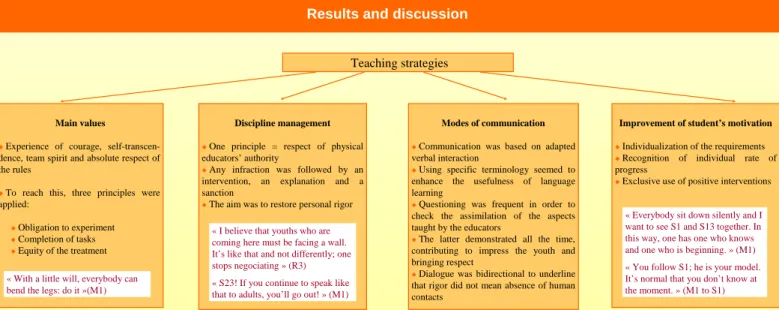Department of Sport Sciences
University of Liège (Belgium)
Statement of the problem
Goals of the study
Sport as support for school reintegration.
A case study
Results and discussion
2 0 1 0 AI ES EP W o rl d Co ng re ss – A Cor u n a (S ap in ) – O ct ob er 26 -2 9
XTo answer to the request of the “principal” of one martial art school working with youths rejecting school.
XTo identify the teaching strategies that are used by the physical educators with youths who have dropped out the school.
XTo analyze other aspects as the specific context of the practice, the evolution of the students’ behaviour (not developed in this poster).
Teaching strategies
Ask references to the first author: Marc.Cloes@ulg.ac.be
François DIJON
Anne-Aymone MARAITE
Marc CLOES
XSport is considered as a mean to be used in order to struggle against some of the problems that society is facing in most developed countries: lack of social cohesion, school and social disengagement, lack of social references, urban violence …
XThe role that sport had to play in social integration seems based more on traditional concepts related to the fundamental values of sport than on objective data.
XAccording to the context, sport can have as much negative as positive social impacts (Committee of the Regions, 1996).
XFinally, few projects are effectively implemented as “integration sport” Î few research to identify the characteristics of this kind of activities.
XVandermeulen & Cloes (2009) pointed out that “sport for insertion” was not really supported while young people with school drop out would need to be considered.
XTheeboom et al. (2008) underlined that several “social workers” are using martial arts as support to their project of insertion. Moreover, even if positive socio-psychological effect were identified, there is a lack of empirical data about the structural characteristics of the projects, the approach proposed by the educators as well as the participants characteristics.
Conclusion
XThis study respected a qualitative approach.
XData were collected between October 2008 and March 2009 according a real triangulation process (analysis of written material, participating observation, interviews with the educators, interview and questionnaire with the youth, analysis of the teaching process) (Figure 2).
X6 adults involved in the project.
X85 youths (12-18 year-old, girls and boys).
XA content analysis has been processed to identify any information and classify it according to its units of sense.
XThe data obtained through the various sources were organized in parallel.
XThe reliability of the analysis was based on the cross checking of a part of the available data by two researchers.
XMoreover, the physical educators validated a written report summarizing the findings and their interpretation.
XIn the interviews as well as during the teaching process, it was underlined that the priority = to increase fitness and motor level of the youth in order to make them aware that they are able to achieve something.
XProposing to learn one martial art is an interesting approach as it is an original context where the youth can see that they are competent and able to reach goals working with others.
XThe picture offered by the teaching style demonstrated in this martial art school is the opposite of what is currently recommended in physical education.
XRigor of the activity is self-supported contrary to what happens at school (youths signed a contract testifying that they were determined to do their best to go back to school).
XThe question is to know if some normal students would not need to be educated with this kind of « directive » approach that determines clearly requirements and identified barriers.
Modes of communication
XCommunication was based on adapted verbal interaction
XUsing specific terminology seemed to enhance the usefulness of language learning
XQuestioning was frequent in order to check the assimilation of the aspects taught by the educators
XThe latter demonstrated all the time, contributing to impress the youth and bringing respect
XDialogue was bidirectional to underline that rigor did not mean absence of human contacts
Main values
XExperience of courage, self-transcen-dence, team spirit and absolute respect of the rules
XTo reach this, three principles were applied:
XObligation to experiment
XCompletion of tasks
XEquity of the treatment
Discipline management
XOne principle = respect of physical educators’ authority
XAny infraction was followed by an intervention, an explanation and a sanction
XThe aim was to restore personal rigor
Improvement of student’s motivation
XIndividualization of the requirements
XRecognition of individual rate of progress
XExclusive use of positive interventions
Decision-makers Experts V S W SAS : Asbl Kung-fu Academy « La Mante belge » Educators Families Schools Other structures Society Sport educators
Methods
EducatorsXThe status of the activity (originality of Kung-fu compared to traditional sports – new skills, new terminology…) and the expertise of the educators (who proposed impressive demonstrations) urged the youths to accept the context (another framework is acceptable). Figure 1 – Context of the study
Figure 2 – Data collecting
« Everybody sit down silently and I want to see S1 and S13 together. In this way, one has one who knows and one who is beginning. » (M1) « You follow S1; he is your model. It’s normal that you don’t know at the moment. » (M1 to S1) « I believe that youths who are
coming here must be facing a wall. It’s like that and not differently; one stops negociating » (R3) « S23! If you continue to speak like that to adults, you’ll go out! » (M1) « With a little will, everybody can
bend the legs: do it »(M1)
Decision-makers
